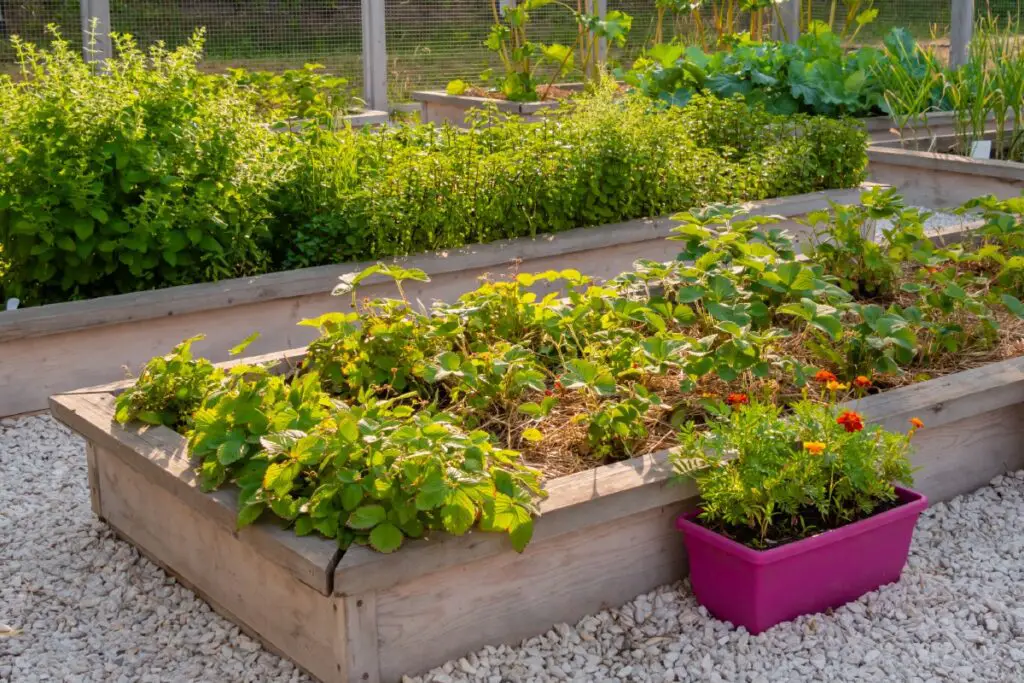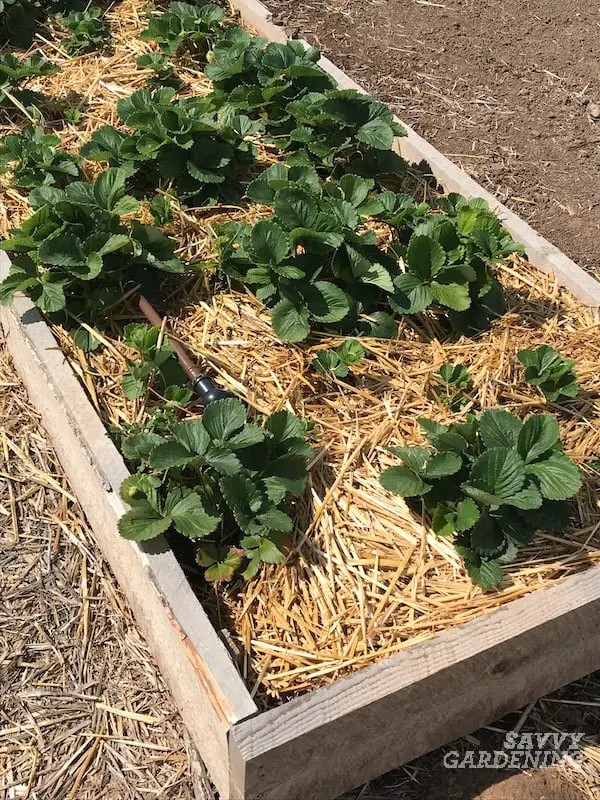Strawberries are a popular choice for home gardeners, and planting them in a raised bed can offer several benefits. But what should you plant alongside your strawberries to maximize your garden’s potential? This article explores the ideal companions for strawberries in raised beds, highlighting the plants that can contribute to enhanced growth, pest control, and overall garden health. By carefully selecting compatible plants, you can create a thriving ecosystem in your raised bed and enjoy a bountiful harvest of strawberries.
Complementary Plants for Strawberries
When planning your raised bed garden, it’s important to consider the complementary plants that can be grown alongside strawberries. Companions can help improve the growth and productivity of strawberries, while also providing benefits such as pest control, shade regulation, and enhanced soil fertility. In this article, we will explore various categories of complementary plants, including leafy greens, herbs, flowers, and companion vegetables, along with the factors to consider for successful companion planting.
| Companion Plant | Category | Benefits | Considerations |
|---|---|---|---|
| Lettuce | Leafy Greens | Provides shade, does not compete for nutrients | Prefers partial shade, keeps soil moist |
| Spinach | Leafy Greens | Helps in moisture retention, attracts beneficial insects | Shallow roots, non-competitive |
| Basil | Herbs | Repels pests like mosquitoes and aphids | Needs full sun, aromatic |
| Thyme | Herbs | Attracts pollinators, enhances flavor | Requires little water, full sun |
| Rosemary | Herbs | Deters pests, improves plant health | Prefers well-drained soil, full to partial sun |
| Marigolds | Flowers | Repels nematodes, aphids, and whiteflies | Full sun, adds color |
| Dianthus | Flowers | Attracts beneficial insects, adds color | Prefers slightly alkaline soil |
| Nasturtiums | Flowers | Deterring aphids, acts as trap crop | Edible, prefers poor soil |
| Tomatoes | Vegetables | Similar nutrient requirements, provides shade | Needs trellising, regular watering |
| Peppers | Vegetables | Contains capsaicin, deters pests | Prefers warm conditions, full sun |
| Carrots | Vegetables | Improves soil structure, does not compete for space | Needs deep, well-drained soil |
Leafy Greens
Leafy greens are excellent companions for strawberries, as they provide shade to the delicate strawberry plants and help regulate soil temperature and moisture levels. Lettuce, spinach, and arugula are particularly suitable choices. These leafy greens have shallow root systems and do not compete significantly with strawberries for nutrients, making them ideal for planting in close proximity.
Lettuce, with its broad leaves, forms a natural shade cover for strawberries, protecting them from excessive sunlight during hot summer days. Meanwhile, spinach helps in moisture retention, minimizing evaporation and keeping the soil consistently moist. Arugula, known for its slightly peppery flavor, not only adds a delightful taste to salads but also attracts beneficial insects that feed on strawberry pests.

Herbs
Herbs not only add a burst of flavor to your culinary creations but can also serve as beneficial companions to strawberries. Basil, thyme, and rosemary are among the herbs that can be successfully grown alongside strawberries in a raised bed.
Basil is especially renowned for its ability to repel pests, such as mosquitoes and aphids, which can pose a threat to strawberry plants. Thyme, with its aromatic foliage, attracts pollinators like bees and butterflies, ensuring efficient pollination for better fruit set. Rosemary, known for its distinctive scent, acts as a natural deterrent to certain strawberry pests and can enhance the overall health of the strawberry plants.
Flowers
Flowering plants not only lend beauty to your garden but also provide numerous benefits when paired with strawberries. Marigolds, dianthus, and nasturtiums are popular choices for companion planting with strawberries.
Marigolds, with their vibrant orange and yellow blooms, act as a natural pest repellent. They have a strong scent that can deter harmful insects like nematodes, aphids, and whiteflies. Dianthus, also known as carnations, not only add a splash of color but can attract beneficial insects such as ladybugs and lacewings, which prey upon strawberry pests. Nasturtiums, with their edible flowers, help in deterring aphids and other pests while also acting as a trap crop for caterpillars.

Companion Vegetables
Certain vegetables can also make excellent companions for strawberries, as they complement each other in terms of growth requirements and pest control. Tomatoes, peppers, and carrots are popular choices for companion planting with strawberries.
Tomatoes and strawberries share similar nutrient requirements, and their different root depths allow them to effectively utilize soil nutrients without competing with each other. Additionally, the tall foliage of tomatoes can provide shade for the lower-growing strawberry plants. Peppers, particularly chili peppers, contain capsaicin, which acts as a natural deterrent to pests like aphids and spider mites. Carrots, with their deep root systems, can help create channels in the soil that improve drainage for both strawberries and themselves.
Factors to Consider for Companion Planting
Successful companion planting relies on considering various factors, such as sunlight requirements, soil preferences, height and spread, and pest resistance. Understanding these factors will help you select the most appropriate complementary plants for your strawberries.
Sunlight Requirements
Strawberries generally prefer full sun, but some companion plants thrive better in partial shade. When selecting companion plants, it is essential to consider their sunlight requirements and choose those that are compatible with your strawberries’ needs.
Some partial shade plants that can be grown alongside strawberries include certain varieties of leafy greens like kale, Swiss chard, and mustard greens. These plants can tolerate some shade and benefit from the partial shade cast by the strawberry plants. On the other hand, full sun plants like basil, thyme, and marigolds require at least six to eight hours of direct sunlight and should be placed strategically in sunnier areas of the raised bed.
Soil Preferences
Different plants have varying soil preferences in terms of pH levels and nutrient content. Understanding these preferences is crucial for successful companion planting.
Strawberries generally prefer slightly acidic soil with a pH range of 5.5 to 6.5. To maintain the ideal soil conditions, it is beneficial to choose companion plants that have similar soil preferences. Acidic soil plants like lettuce, spinach, and dianthus are excellent choices as they share the same soil pH requirements as strawberries. Alternatively, alkaline soil plants such as arugula, rosemary, and peppers can also thrive alongside strawberries, provided the soil is amended accordingly.

Height and Spread
Consider the height and spread of your chosen companion plants and ensure they do not overshadow or overcrowd the strawberry plants. Proper spacing is essential for good air circulation and light penetration, which can prevent the development of diseases.
Low-growing plants like lettuce, spinach, and arugula make great companions as they won’t overshadow or compete for resources with strawberries. Vine plants, such as certain varieties of tomatoes, can be trained on trellises or cages to minimize their footprint, while still providing shade to the strawberries. Bushy plants like marigolds and peppers can be strategically placed at the edges of the raised bed to add a beautiful border and maximize space utilization.
Pest Resistance
One of the significant advantages of companion planting is pest control. Certain plant combinations can repel pests or attract beneficial insects, reducing the need for chemical pesticides and promoting natural pest management.
Repellent plants such as basil, thyme, and marigolds have strong scents that deter pests like aphids, whiteflies, and nematodes. These plants can act as a natural barrier around the strawberries, protecting them from infestations. Additionally, trap crops like nasturtiums or dianthus can attract pests away from strawberries, acting as sacrificial plants while sparing the strawberries from damage.
In conclusion, when planning your raised bed garden, consider companion planting to enhance the growth and productivity of your strawberries. Leafy greens, herbs, flowers, and companion vegetables can provide shade, pest control, and soil fertility benefits. Factors such as sunlight requirements, soil preferences, height and spread, and pest resistance should be carefully evaluated when selecting companion plants for successful gardening. With thoughtful planning and careful consideration of these factors, your strawberry plants will thrive alongside their complementary companions, resulting in a bountiful and thriving garden.



